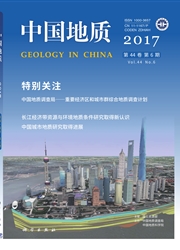

 中文摘要:
中文摘要:
乌兰乌珠尔斑岩铜矿位于柴达木盆地西缘。为受花岗斑岩脉控制的斑岩型铜矿。岩石化学、稀土和微量元素特征表明:控矿花岗斑岩与围岩(似斑状)斜长花岗岩为钙碱性系列,具轻稀土富集、显著的δEu负异常和Sr、Ba、Ca亏损特征,形成于同碰撞造山环境。与华力西晚期一印支期松潘一甘孜古特提斯洋俯冲碰撞闭合有关。控矿花岗斑岩及其围岩热液蚀变强烈,显示良好的蚀变分带。主要蚀变有钾硅化、绢英岩化和青磐岩化。控矿斑岩内部为钾化和硅化叠加绢英岩化带,近斑岩两侧围岩为绢英岩化带,外侧为青磐岩化带。铜矿化强度与蚀变强度有显著正相关关系。铜矿体空间分布、产状及规模受控矿花岗斑岩体控制。矿床的矿物组合、热液蚀变、硫、氧同位素和流体包裹体测温结果显示矿床形成于中高温环境.流体和成矿物质主要来源于岩浆.乌兰乌珠尔铜矿属与高中温岩浆热液作用有关的斑岩型铜矿。
 英文摘要:
英文摘要:
The Ulan Uzhur copper deposit, situated on the western margin of the Qaidam basin is a porphyry copper deposit controlled by granite porphyry dikes. The major element, rare earth element (REE) and trace element characteristics indicate that ore-controlling granite porphyry and its wall rock plagiogranite (porphyritic) belong to the calc-alkaline series characterized by enrichment of LREE, pronounced negative Eu anomalies and depletion of St, Ba and Ca. They formed in a syncoUisional orogenic environment and are related to the subduction-collision and closing of the late Variscan-Indosinian Songpan-Garze Paleo-Tethys ocean. The orecontrolling granite porphyry and its wall rocks underwent strong hydrothermal alteration and show apparent alteration zoning. The main hydrothermal alteration includes potassic, phyllic and porphyritic alteration. The core of the granite porphyry is usually marked by a zone of potassic and silicic alteration superimposed by phyUic alteration, and the wall rocks adjacent to the granite porphyry are phyllic zones, and those distal to the granite porphyry are propylitic zones. The intensity of mineralization is apparently positively correlated to the intensity of alteration. The spatial distribution, attitude and size of the copper orebodies are also controlled by granite porphyry. The mineral assemblage, hydrothermal alteration, sulfur and oxygen isotopic compositions and results of microthermometric measurements of fluid inclusions-all suggest that the Ulan Uzhur copper deposit formed at high to medium temperatures and that the ore-forming fluids and materials were derived from magma. So the deposit is a porphyry copper deposit related to hypo- and mesothermal processes.
 同期刊论文项目
同期刊论文项目
 同项目期刊论文
同项目期刊论文
 期刊信息
期刊信息
